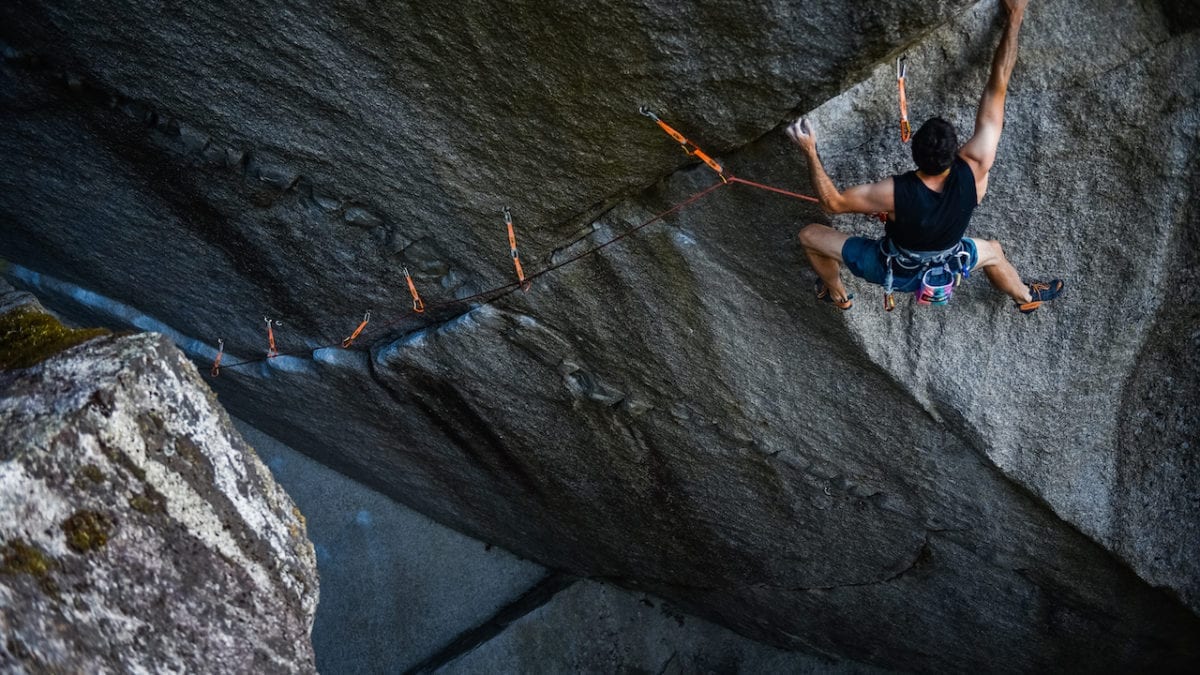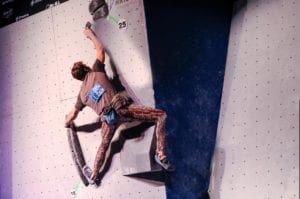Top Climber Talks About Struggle with Eating Disorder
Squamish-based climber Jake Scharfman opens up about his experiences with eating disorders and climbing.

“From the shoes to the skin, Eating Disorders (ED) can be viewed as just another discomfort. In reality they have way longer lasting health repercussions and have much more serious side-effects.”
Jacob Scharfman was born in Santa Fe, New Mexico. He is 21-years-old and currently attends Quest University in Squamish. Over the last three years, Scharfman has become one of Squamish’s strongest climbers. Though he spends most of his time climbing classics, searching out new problems, or photographing some of Canada’s best, Scharfman’s introduction to the sport was like most: in the gym.
“When I first started, I was a gym climber. Competition climbing seemed like the logical progression of the sport.”
Over the course of his career, Scharfman would go onto to climb multiple national competitions, ultimately making the US team in his final year in the Junior category. He would go onto to represent his country at Youth World’s in Russia. Though Scharfman looks back on his time competing as a period filled with friends and a passion for climbing, the pressure of the sport would ultimately push Scharfman to some complicated places. Eventually, Scharfman would begin counting calories.
Climbing at a calorie deficit as a manner of training is not new to the sport. You may have heard of the 16-hour-fast diet, or the generally consideration that carbohydrates are unhealthy, characterize as “carbs are bad.” From unguided calorie counting, to generally negative food associations, there are many ways that climbers try to manage their weights.
Why is this the case? Well, it can be difficult to not think about climbing performance in reference to a ratio. This is the ratio between strength and weight. The idea is that if a climber weighs less, they will not need to be as much strength to climb harder. If you have ever completed a weighted hang on a hangboard, you may have had this thought yourself. Sometimes just adding 10 pounds of weight can feel incredibly challenging. As such, it is easy for climbers to wonder at what might happen if they lost those 10 pounds instead. This is what can lead a climber down an increasingly dangerous road and can begin a toxic conversation about “fear foods” and “safe foods.”
Scharfman said, “A ‘fear food’ is a food that didn’t fit in with what I thought was ‘okay’ to eat.” This mentality was a part of what would eventually be diagnosed as his ED. What is an eating disorder? According to Scharfman, “An eating disorder happens when anyone builds an unhealthy relationship with food. I think that a lot of people, when they first think of an eating disorder, focus in on anorexia or bulimia, but it can also be issues with overeating or other stuff like that.”
For Scharfman, his battle was with under-eating in relation to climbing performance. He said, “In preparation for Youth Nationals, I decided to start thinking about calories. I decided to lose a couple pounds just for the competition and to start being aware of what I was eating. I lost those couple of pounds, nothing crazy, and then had the best results of my competition life. I equated that with weight loss because that was the only ‘real training’ I had done specifically different. That ‘positive’ reinforcement started having me go further and further. I really got into a mind space of ‘lighter is better.’ That became my mantra for climbing performance. You get to thinking about it as a ratio when that’s not how our bodies work. It’s not proportional.”
Unfortunately, ED can take a long time to exhibit negative consequences in male athletes. According to a paper by Antonia Baum of Fairfax Hospital’s Department of Psychiatry, “male athletes can far more easily sustain lower body fat (in the order of 1%) without profound medical consequences.”
As such, the consequences Scharfman originally experienced as he cut weight appeared positive. He said, “For a while I was just climbing my strongest and it was awesome. I just started going smaller and smaller on the calories and impulsively weighing myself, doing 800 calorie weeks and fasting days. At the worst of it, I got into bulimia and purging. Even though I was in shit health, I still felt like I had to keep training at the same level. I was doing three-to-four-hour sessions in the gym and feeling frozen because I didn’t have enough calories. I would spend 30 minutes in the sauna to try and warm up. My muscles atrophied, I got super skinny, lost all of my strength, had trouble doing pull-ups, and yet my thought process was still, ‘well I am losing all of this strength, so to compensate, I am just going to get lighter.”
Over six months, Scharfman would lose over 30% of his weight. It wouldn’t be until many of people in his life had asked him to just go to the doctor for a check-up that he would ultimately do so. He said, “Until I went to the doctor and was told clinically that it was an eating disorder, I never thought it was an issue.”
Following his visit to the doctor, Scharfman was forced to take 2 months off of climbing. He said, “It was not a super long time. In retrospect, I think it should have been longer for me. The crazy thing I want to highlight is that ata weight requiring hospitalization, my BMI (Body Mass Index) was still right around the line of ‘what’s healthy’ and still very much within the competition BMI that is presented in the IFSC, even though my heart rate was down low enough that I was at risk of cardiovascular issues.”
Scharfman went on to say, “I just want to highlight how poor a measurement of BMI can be in our sport, even though it is also the most prevalent.” To that end, it is almost shocking that something like this could go undiagnosed for so long for an athlete competing on the world stage. Scharfman notes, “Because this is a new, growing sport, and this issue is only really being talked about in the last few years, there’s no support for it yet within the sport, there’s no systems in place.”
Though the IFSC’s BMI index is supposed to help eliminate problems such as these, everyone has a different body type making BMI a difficult metric. Scharfman said, “I know the IFSC (International Federation of Sport Climbing) has minimum BMIs, but they are so low that it doesn’t really matter. I have heard stories of top athletes being so malnourished that they can’t even warm up for the competition.”
The metric is designed around measuring your height as a ratio to your weight. In climbing, it used to regulate and calculate minimum “healthy” weights.
As mentioned before, this issue has only recently received attention from the greater climbing community with a few professional athletes making public statements. American climber Kai Lightner posted last year.
Scharfman finds this exceptional, stating, “I think what the climbing community needs to do to move forward on these issues are louder voices from the professionals in the sport. I think the major sporting organizations like CEC (Climbing Escalade Canada), USA Climbing, and the IFSC need to have integrated resources for athletes that might be struggling with these issues. I honestly don’t know what that might look like, but I think it very much needs to happen.”
“The minimums to compete are hard ones because we all have different body types. The BMI thing certainly doesn’t work. It needs more open conversations from all levels of participants in the sport, and it needs to be a more normalized conversation than it has been historically. I think we are seeing at least a little bit more progress on that, but there is a lot more work that needs to be done if we are going to be a healthier sport. Conversation and normalization are the two biggest things because they are accessible to everyone and can perforate through the industry.”
With that said, why is it that the climbing community is so afraid to talk about these issues? Scharfman theorizes, “I think it relates to that culture of hardness or toughness, not wanting to show weakness. I think as climbers we often like to think ourselves exempt from a lot of the larger social issues, like toxic masculinity among other things, but it’s ingrained everywhere. We are all people that have been exposed to it. Wanting to promote this tough exterior around other climbers closes off some of those more vulnerable conversations around things like eating disorders.”
Though climbing is a sport filled with discomfort, calorie deficits should not be a metric by which we measure our commitment to the sport. Scharfman said “In reality, if you’re training, you can eat anything so long as you maintain overall proper nutrition. A slice of cake, or a milkshake isn’t going to kill you. It’s a normal part of being a human, and denying those things to ourselves is going to cause more harm than good.”
Scharfman looks back on his last three years and recognizes the damages his ED brought him. “I was super unhappy. In a severe calorie deficit I was snappy, I never felt good, I was meaner, it was just not good for me or anyone around me. Now that I do have the proper fuel for my body, I am just a happier human.”
“I don’t think it will ever be fully resolved for me. I still don’t weigh myself as a coping mechanism for maintaining a healthy training weight and climbing as my heathy self. I think it will be a very long time before I am able to look at food and at least not think about the calories involved. But it is now at a point for me where it is super manageable and not triggering to talk about it. I have disordered thoughts around food occasionally, but I think the behaviour is something I am well and truly done with.”
“The biggest thing I am excited about is continuing to rebuild my climbing relationship in a way that is not solely set around performance. Working on being okay with the body type that I have and trying to train to my inherent strengths as opposed to trying to train to be the type of climber other climbers are. I want to try problems that are cool as opposed to grade chasing and find other ways to engage with the community.”
One such way the Scharfman engages with the community is in his aforementioned photography. You can view his work here.
Canada-based Eating-Disorder-specific health services can be found here. US-based health services can be found here.




